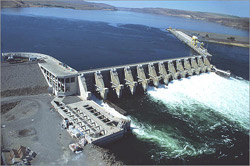 Hydro Power Facts
Hydro Power Facts
Hydro power is the most significant renewable energy source. Hydro power is the only renewable energy source that is in some measure competitive with fossil fuels.
Hydro power can be used anywhere in the world where there's falling water.
Hydro energy was used by the Greeks to turn water wheels for grinding wheat into flour, more than 2,000 years ago.
In the 1770s, French hydraulic and military engineer Bernard Forest de Bélidor wrote Architecture Hydraulique, a four-volume work describing vertical and horizontal axis machines.
1880 - Michigan's Grand Rapids Electric Light and Power Company lit up 16 arc lamps by generating electricity from a water turbine at the Wolverine Chair Factory.
1881 - Niagara Falls city street lamps are converted to power provided by hydro energy.
1882 - World's first hydro energy power plant goes into operation on the Fox River in Appleton, Wisconsin.
1886 - 45 hydro energy electric plants exist in the U.S. and Canada.
1889 - Two hundred electric plants in the U.S. use waterpower for some or all generation.
1901 - First Federal Water Power Act.
1907 - Hydro energy provides 15% of all electricity in the United States.
1920 - Hydro energy provided 25% of all electricity in the United States.
1933 - Tennessee Valley Authority established.
1937 - Bonneville Dam, first Federal dam, begins hydro energy production on the Columbia River.
1940 - Hydro energy provided 40% of electrical generation in the United States.
2003 - About 10% of U.S. electricity comes from hydro energy as population growth, increased power needs and environmental issues reduce reliance on hydro energy.
Today, there is about 80,000 MW of conventional hydro energy capacity and 18,000 MW of pumped storage in the U.S.
Hydro energy produces about 20 percent of the total electricity in the world.
Canada is the largest producer of hydro energy in the world.
The U.S. is second followed by Russia, Brazil and China.
Norway produces almost 100 percent of its electricity through hydro energy.
Hydro power plants have an edge over their coal counterparts in terms of efficiency as well. While hydro power plants can convert 90 percent of the total energy available into electricity, coal plants can only covert 50 percent of the available energy into electricity.
A modern-day hydro power plant is divided into three parts - the electric plant, dam and the reservoir. The reservoir is used to store the water, the dam is used to control the flow of water and the electric plant is the place where electricity is produced.
Hydroelectric energy generation is the cheapest source of energy on the planet. While most of the investment revolves around the construction of reservoir, water is available free of cost. Most of these hydro power stations tend to recover their set up cost within 8 years of starting operation.
